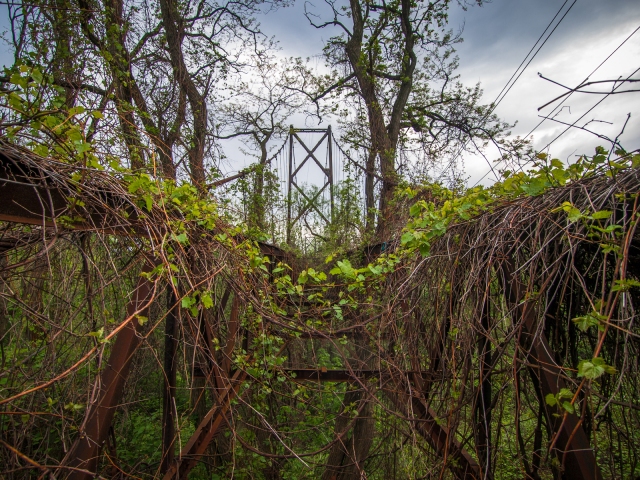
Sidaway Bridge, Hough Riots and the Cleveland Torso Murders
The Sidaway Bridge is a historic footbridge in Cleveland, Ohio.

The original purpose of this bridge was to bring two neighborhoods together, rather than being divided. It was an effort made to stop feuding between separate Polish and Hungarian neighborhoods in Cleveland. It was believed that this would contribute to their mutual commercial and general welfare. The original bridge was built in 1909 by the Tom Johnson administration, and was originally named the Tod-Kinsman Bridge. The bridge connected the Kinsman Road and Jackowo neighborhoods. Only a year later, the name was changed to the Sidaway Bridge. This bridge held for more than 20 years, serving its initial purpose, as well as providing a shortcut for people to walk over to Dahler’s – which was a popular beer garden in the Jackowo neighborhood. By the late 1920s, plans were hatched by the Nickel Plate Railroad, who had wished to build several car barns beneath the bridge. The bridge was an obstruction where they wished to build, and it was agreed between both parties that if the railroad paid for both deconstruction, and reconstruction, that the bridge would be dismantled, with a new bridge put in its place. The new bridge would still serve the same purpose, carrying people from one neighborhood to the other, but at the same time would open up more space below for the new rapid transit buildings.




The new bridge was designed in 1929 by Fred L. Plummer. Plummer was a Cleveland-based engineer, who had also served as a professor of engineering at the Case School of Applied Science (the same school that had built the now abandoned observatory.)
The new bridge was completed in 1930, and still remains the only suspension bridge ever built in Cleveland. Suspension bridges were largely popular in the United States during the 1920s. Constructed with a series of weight-bearing steel cables, they allow for very long bridge decks without the use of numerous support towers, leaving space open below.



Only a few years after the opening of this new bridge, it had become the site of a string of murders, known as the Cleveland Torso Murders. These murders occurred between 1935-1938, and included 12 women, 4 of which had their corpses dumped off various sides of the bridge. The bodies were found scattered around the hillside beneath the bridge. Nearly 4 years after these murders had stopped, city officials found the body of another woman beneath the bridge.
By the 1960s, feuding began to break out between the neighborhoods. In a city where, in the early 1960s, racial tension was still very high, you now had a mostly black neighborhood connected to a mostly white neighborhood. As African-American residents began to populate the Kinsman road neighborhood, more and more African-American children would use the Sidaway Bridge to walk to Tod Elementary School in the Jackowo neighborhood. Six years of built up racial tension eventually brought the Hough Riots of 1966. During these riots, residents from the Jackowo neighborhood removed some of the wooden planks on their side of the bridge, and attempted to set the bridge on fire, preventing anyone from using it. Rather than repairing the bridge, and opening it back up to the public, the city decided to just close the bridge to any further use. A decade later, this would come back quite negatively on the city of Cleveland.



In 1976, federal district court judge Frank Battisti was issuing his busing order to desegregate Cleveland’s public schools. He criticized the city for their actions in 1966 for closing the bridge, using it as evidence to say that city and school officials had worked together to segregate the schools on the basis of race. This was a very bad and embarrassing look for the city of Cleveland. It has now been 53 years since the Hough Riots. The bridge has sat abandoned and quietly collecting rust for all these years, continuing a steady cycle of becoming overgrown in the summers, and frozen in the winters. Many plans have been proposed to restore the bridge, to serve the purpose for which it was built, but all have fallen through to this point. This dilapidated bridge serves as a sad, grim reminder of the horrible divide and awful negativity that racial discrimination can bring. We should all work together as humans, not against one another.






Perfect combination of photography & history, hope & fear, beauty & ugliness. Really drew me in. Thanks. Wish I could take a few more steps into the picture above your caption “under the bridge” –stand right by that piece of curved metal (railing? … part of the bridge?) and peek over edge.
Thank you so much! I’m glad you enjoyed it!